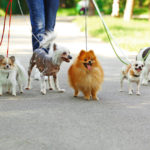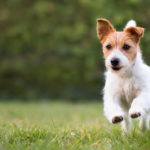When you drive your dog to a new and exciting location, does he bounce up and down with excitement or shiver in the car seat? Does he shy away from outstretched hands and cower behind your legs when meeting new people or bound towards them with glee?
Canine confidence is a lot more than just encouragement and strutting down the boulevard with a wagging tail. A confident dog is able to adapt to any situation with ease and therefore able to handle unfamiliar situations and surroundings without any nervous hesitation.

A pooch’s ability to be confident is a result of nature and nurture. Whilst some dogs may be genetically predisposed to being anxious and more fearful than others, this tends to be an excuse.
If the owner socializes their dog constantly during puppyhood, they will build the necessary confidence to approach new people and situations without cowering fear.
Luckily, if your dog is the nervous type, there are crucial lessons that you can teach them at any stage in their life that will encourage them to build that crucial canine swager in a ‘dog eat dog’ world.
Why Is It Important For Your Dog To Be Confident?
Being confident enables your dog to take life’s daily challenges and stresses in its stride. Fear, discomfort, PTSD, and other stress reactions are common with dogs and so it is important to treat each pooch as a differing protege being coached by the head of the basketball team.
A dog needs to hear the confidence in your tone and approach to believe that unfamiliar sounds and situations are not to be feared.
Like their human companions, dogs that are under frequent stress are more prone to disease and those that deal with frequent spikes in stress hormones are also more likely to develop problems like diarrhea, nausea, loss of appetite and a negatively affected immune system.
A dog that is prone to nervousness may also exude signs of bad behavior and dangerous reactivity and this can be difficult for owners to respond to appropriately.
Many aggressive reactions can be misinterpreted and cause the animal to be punished, which only further prolongs their discomfort and anxiety. Building a dog’s confidence is therefore imperative to ensure the happiness of all who interact with it.
How To Build? – Let Your Dog Lead
Unlike their feline companions, dogs are typically dependent animals who need their owner for everything, ranging from food to walks to adoration. So it is important to introduce your dog to the idea of self-control and that includes how they respond to their surrounding environment.
Whether it’s meeting new people or adapting to new surroundings, allow your pooch the opportunity to mark their territory in their own time. If the new individuals are forceful and overwhelm your dog, ask them to take a step back and explain the situation straight away.
This lets your dog know that you are there to protect them and that you understand their limitations at this stage. Then, set the pace for interactions that aren’t as claustrophobic at a pace that lets him know that he is not going to be forced or coerced into triggering situations.
See The World How Your Dog Sees It
Some things that trigger your canine may concern or even surprise you. But through careful observation, you’ll be better equipped to recognize them and defuse the situation before anything problematic occurs.
For example, your dog may feel nervous the first time that he hears a hairdryer or maybe he has an adverse reaction to a stranger with a long, frizzy beard.
Rather than assuming that it is an overreaction on your dog’s behalf, try to imagine what it is like to look up and see an unfamiliar man with a beard towering over you.
The more empathy that you can extend towards your dog’s stress, the more likely you are to be able to exude the patience necessary to build the trust and confidence of your beloved pooch.
Use Positive Reinforcement
In dogs and humans alike, there is nothing that comes close to the confidence boost experienced after learning a new skill or completing a team-based activity. Train your dog using fun, uplifting, dog-friendly techniques.
For example, if your dog becomes nervous around moving objects like bicycles or skateboards, ask him to ‘watch’ you instead, using treats as a stimulant. Maintain his eye contact and offer him continual assurance until the rider has ridden past you both.
Identify Your Dog’s Triggers
Fearful dogs can often be unpredictable in their reactions, leading them into a place of reactivity or withdrawal. It is important to pay close attention to your dog and identify each individual trigger so that they can be dealt with intimately and accurately.
This may feel like an arduous process if most things scare your dog, but this attention to detail will pay off in the long run as the more that your dog becomes aware that multiple triggers aren’t threatening to him, the more likely you are to induce a ‘domino effect’ of confidence in regards to all of their triggers.
If your dog is fearful of coming into a specific room, for example, as it is triggered by the sounds of it’s own nails on the floorboards or the echoes against the walls, counter-conditioning like positive reinforcement and enthusiastic gesturing will let your dog know that this is a space space to enter.
Understand The Impact Of Body Language
Dog’s are masters of communicating via body language, their heightened senses keep them in a constant flux of bodily communication.
As humans, we have become dependent on our words for most forms of communication, however, we also reveal more than we are aware of through our own body language.
Adopting a calm, postured, confident presence around your animal will work wonders for encouraging them to also become confident. In turn, this will also strengthen the tonality of your voice without you necessarily needing to sound ‘firm’ or worse, stressed.
Many people misinterpret a dog’s body language, for example, people assume that a wagging tail is indicative of happiness whereas it can mean a variety of things. Close observation of your dog is the only way to determine how it actually feels within any given situation.
Presumption is the enemy of progress when it comes to building confidence in an unpredictable and nervous pet. Don’t assume that they should or will react a certain way in situations just because another animal does.
Your dog is an individual and should be treated with respect, paying attention to their own individual needs and bodily traits.
Teach Your Dog ‘Touch’
Teaching your dog how to like being touched may be a long process if you have a rescue animal or any dog that has been mistreated in the past. A technique called ‘targeting’ is the best way to approach this.
‘Targeting’ is where you allow your dog to take the lead and place any part of its body against your palm. It is imperative that you allow your dog to lead in this process and an open, presented palm is all that is required from you.
Then, when your dog touches your palm, use words of encouragement like ‘yes’ and ‘good boy/girl’ followed by a treat to ensure that your pooch associates ‘touch’ with positivity and empowerment.
In conclusion, building confidence in your canine requires you to allow them to take control and lead the process. Like with human beings, codependence only degrades the internal sense of self and this is exactly the same in dogs.
If you pay attention to your animal’s needs and exercise the right level of patience, your dog will build the confidence needed to be strutting down the street in no time.
- 8 Signs That Your Dog Is In Heat - November 8, 2022
- Why Is My Dog Whining Whilst Carrying A Toy In Their Mouth? - August 17, 2022
- Reasons Why Your Dog’s Poop Is White And What To Do About It - August 17, 2022









